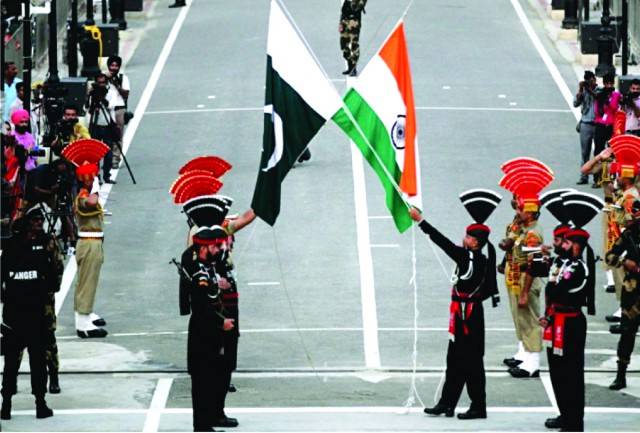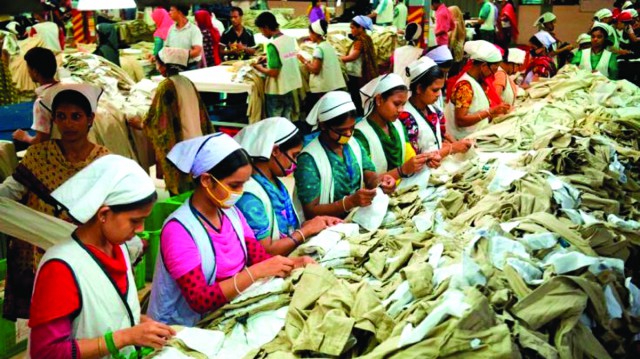
Consider two years in the history of the South Asian Subcontinent: 1947 and 1971. Both were the culmination of long, bloody and painful conflicts that not only led to breakup of two states but also to an everlasting saga of ethnic violence, religious intolerance and hatred in the region. While partitions, formation of new states, ethnic violence, religious intolerance and contested identities have often been discussed in a political light, one must realize that the fanfare of politics masquerades a formidable reality of economics that seems to work in the backdrop to define political happenings that bend the shape of history.
Speaking of economics, one is led to imagine that out of the two partitions that happened in 1947 and 1971, only the latter has, as events unfold, turned out to be a partition that led to the formation of two distinct realities. The one in 1947 was different, since the economic fortunes of India and Pakistan came to be identified with very similar economic systems and handicaps. India and Pakistan were able to provide their people with health, education and standards of living that can hardly be separated. However, 1971 formed a new country Bangladesh, which, as the emerging economic data indicates, has positioned itself to be distinguished from the economic entity that one calls the “Indo-Pak” region. Economically, thus, the Subcontinent today can be divided into two distinct economic entities; the old, struggling Indo-Pak and a rising star Bangladesh.

This categorization is born out of evidence recently produced by the Bangladeshi cabinet that reported GDP per capita that has risen comfortably above the GDP per capita estimates of India and Pakistan. India has a large population to feed: in fact the word ‘large’ would be a slight underestimation of the scale that we are dealing with: it has the second largest population amongst the comity of 193 UN member nations. That partly explains – even if it does not justify – India’s arguable failure to promote the economic well-being of its people. Pakistan, on the other hand, has a population much smaller to that of India but its failures in feeding a large population and providing for its economic needs is not materially different to that of India. An estimated population of 220 million living off a GDP which has fallen beneath USD 300 billion – a threshold it breached in FY 2017-18. That brings its GDP per capita to be lowest amongst the three South Asian countries.
On the other hand Bangladesh, once the Eastern flank of Pakistan; disjointed and much less developed, that had separated from its western Pakistani counterpart on grounds of economic injustice and disparities, has developed to attain a higher economic status. It has not only surpassed Pakistan but also the elder sibling in the region, India, to become the regional economic ‘tiger’ – as those aspiring for this title in the region call it. At USD 2,227, the Bengali GDP per capita is much higher than that of a trailing India, which stands at USD 1,937 even after years of growth in excess of 7%.
Dhaka was lost to Pakistan at a time when West Pakistan had a GDP per capita – it is estimated – roughly 70% higher than that of East Pakistan. Today, the Bangladeshis might smile and be proud of this feat: their GDP per capita is roughly 40% higher than that of Pakistan. The size of their economy has also surpassed that of Pakistan’s, which at USD 294 billion stands around USD70 billion less than the Bangladeshi economy of USD 365 billion. With a population much smaller than Pakistan; around 160 million people today reside in Bangladesh, a GDP of 365 billion is not only substantial but also points to a saga of economic success in a region that is rife with fears of mounting adversity and insurmountable failures. A separate article would have to be dedicated to deal with the circumstances that have led to this regional divergence between Bangladesh and Indo-Pak; what led to the Bengali surge and what to the economic stagnation of the latter. I am more inclined to call it a downfall of the Indo-Pak region. However, if one has to identify certain good things that the Bangladeshis did, one must not forget the industrial reforms that led to a steep rise in the level of exports.
Export growth has long been discussed as a significant contributor to economic growth. However, its importance while duly recognized, has not led the policy direction in the Subcontinent. The Bangladeshi story is clearly a different one. Exports at around USD 31 billion represent 14.8% of the GDP. Imports, while much ahead, stand at USD 48 billion and 23.4% of the GDP. Compare that to Pakistan, which had been proposing export-led growth strategies even prior to the formation of Bangladesh, but has exports stagnated at 8.8% of its GDP and at around USD 23 billion. Imports, despite declining recently, thanks to tariffs that have had the impact of banning them, have stood between USD 50 and 60 billion.
The emergence of Bangladesh does point to a regional divergence taking place and that the two partitions did not create three countries, but two. However, while the Indo-Pak region may like to replicate the reforms that led to the Bangladeshi success, what will be more important and interesting to see in times to come is if the leadership in Dhaka is able to create governance mechanisms that can convert the excess resources produced by growth to improve the lives of its people.
After all, growth without development is the task only half done!
The writer is an economist and ex-Director of the Burki Institute of Public Policy (BIPP). He tweets at @AsadAijaz
Speaking of economics, one is led to imagine that out of the two partitions that happened in 1947 and 1971, only the latter has, as events unfold, turned out to be a partition that led to the formation of two distinct realities. The one in 1947 was different, since the economic fortunes of India and Pakistan came to be identified with very similar economic systems and handicaps. India and Pakistan were able to provide their people with health, education and standards of living that can hardly be separated. However, 1971 formed a new country Bangladesh, which, as the emerging economic data indicates, has positioned itself to be distinguished from the economic entity that one calls the “Indo-Pak” region. Economically, thus, the Subcontinent today can be divided into two distinct economic entities; the old, struggling Indo-Pak and a rising star Bangladesh.

This categorization is born out of evidence recently produced by the Bangladeshi cabinet that reported GDP per capita that has risen comfortably above the GDP per capita estimates of India and Pakistan. India has a large population to feed: in fact the word ‘large’ would be a slight underestimation of the scale that we are dealing with: it has the second largest population amongst the comity of 193 UN member nations. That partly explains – even if it does not justify – India’s arguable failure to promote the economic well-being of its people. Pakistan, on the other hand, has a population much smaller to that of India but its failures in feeding a large population and providing for its economic needs is not materially different to that of India. An estimated population of 220 million living off a GDP which has fallen beneath USD 300 billion – a threshold it breached in FY 2017-18. That brings its GDP per capita to be lowest amongst the three South Asian countries.
Dhaka was lost to Pakistan at a time when West Pakistan had a GDP per capita – it is estimated – roughly 70% higher than that of East Pakistan. Today, the Bangladeshis might smile and be proud of this feat: their GDP per capita is roughly 40% higher than that of Pakistan
On the other hand Bangladesh, once the Eastern flank of Pakistan; disjointed and much less developed, that had separated from its western Pakistani counterpart on grounds of economic injustice and disparities, has developed to attain a higher economic status. It has not only surpassed Pakistan but also the elder sibling in the region, India, to become the regional economic ‘tiger’ – as those aspiring for this title in the region call it. At USD 2,227, the Bengali GDP per capita is much higher than that of a trailing India, which stands at USD 1,937 even after years of growth in excess of 7%.
Dhaka was lost to Pakistan at a time when West Pakistan had a GDP per capita – it is estimated – roughly 70% higher than that of East Pakistan. Today, the Bangladeshis might smile and be proud of this feat: their GDP per capita is roughly 40% higher than that of Pakistan. The size of their economy has also surpassed that of Pakistan’s, which at USD 294 billion stands around USD70 billion less than the Bangladeshi economy of USD 365 billion. With a population much smaller than Pakistan; around 160 million people today reside in Bangladesh, a GDP of 365 billion is not only substantial but also points to a saga of economic success in a region that is rife with fears of mounting adversity and insurmountable failures. A separate article would have to be dedicated to deal with the circumstances that have led to this regional divergence between Bangladesh and Indo-Pak; what led to the Bengali surge and what to the economic stagnation of the latter. I am more inclined to call it a downfall of the Indo-Pak region. However, if one has to identify certain good things that the Bangladeshis did, one must not forget the industrial reforms that led to a steep rise in the level of exports.
Export growth has long been discussed as a significant contributor to economic growth. However, its importance while duly recognized, has not led the policy direction in the Subcontinent. The Bangladeshi story is clearly a different one. Exports at around USD 31 billion represent 14.8% of the GDP. Imports, while much ahead, stand at USD 48 billion and 23.4% of the GDP. Compare that to Pakistan, which had been proposing export-led growth strategies even prior to the formation of Bangladesh, but has exports stagnated at 8.8% of its GDP and at around USD 23 billion. Imports, despite declining recently, thanks to tariffs that have had the impact of banning them, have stood between USD 50 and 60 billion.
The emergence of Bangladesh does point to a regional divergence taking place and that the two partitions did not create three countries, but two. However, while the Indo-Pak region may like to replicate the reforms that led to the Bangladeshi success, what will be more important and interesting to see in times to come is if the leadership in Dhaka is able to create governance mechanisms that can convert the excess resources produced by growth to improve the lives of its people.
After all, growth without development is the task only half done!
The writer is an economist and ex-Director of the Burki Institute of Public Policy (BIPP). He tweets at @AsadAijaz

